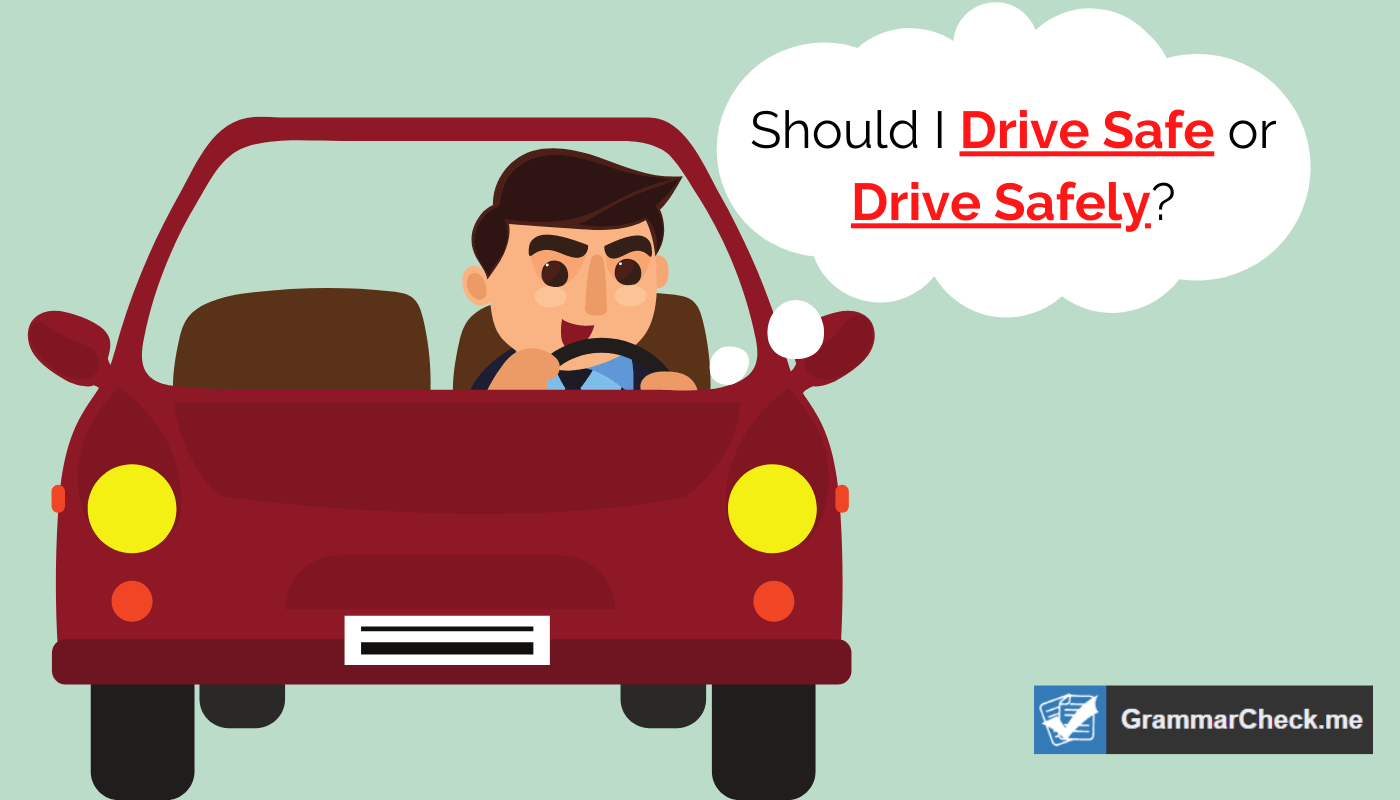“Drive safe” is an informal expression wishing someone to be safe while driving, while “drive safely” is the grammatically correct adverbial form advising how to drive.
Where do you stand on the Drive Safe or Drive Safely debate? Are they both equally correct, or are there subtle differences between the two phrases? The English language is full of words & phrases that seem identical, but often have slightly different meanings, just like the words pricy or pricey. In this blog post, we’ll take a closer look at these two phrases and find out which one is grammatically correct.
Always using the right words? Make sure:
Check Your TextWhich Is Correct: Drive Safe or Drive Safely?

“Safe” and “safely” are both adverbs just like yep vs yup. Adverbs modify verbs, adjectives, or even other adverbs! Just be sure to know the difference between verb vs predicate in your writing.
The only difference is that “safe” is a flat adverb. You can identify flat adverbs easily because they function just like regular adverbs, but they are missing the -ly. Adverbs like this can even be changed into adjectives depending on the context of the sentence. In fact, flat adverbs have the same form as their related adjectives.
- Drive Safe – This phrase should only be used as a parting farewell. For example, “Drive safe and watch out for deer”. So, when someone says “drive safe,” what they really mean is “be careful.” It is more commonly used in casual speech or conversation.
- Drive Safely – This phrase is considered grammatically correct in all other contexts. The phrase “drive safely” is usually used as a polite way of saying goodbye to someone who is about to get into a car and drive. It can also be used to describe the manner in which someone drives.
Takeaway: Both terms can be used to say farewell. However, “drive safely” should be used in all other contexts.
What Are Sentence Examples For Drive Safe?
Here are sentence examples for “drive safe”.
- Remember to drive safe on the icy roads.
- Text me when you get there, and drive safe!
- It’s foggy out there; drive safe.
- With all the construction work happening, make sure you drive safe.
- I know you’re in a hurry, but please drive safe.
- Drive safe, and watch out for pedestrians.
- After the party, make sure you drive safe back home.
- It’s getting dark early these days, so drive safe.
- Drive safe, the weather forecast mentioned heavy rain tonight.
- Before you head out on your road trip, just a reminder to drive safe
What Are Sentence Examples For Drive Safely?
Here are sentence examples for “drive safely”.
- Please make sure to drive safely in this snowy weather.
- He always reminds his kids to drive safely.
- Drive safely; we want to see you back home soon.
- The road is slippery, so remember to drive safely.
- Before she left, her parents told her to drive safely.
- It’s important to drive safely at all times to avoid accidents.
- Drive safely, and don’t rush, even if you’re late.
- I hope you drive safely through the storm.
- Drive safely, and keep an eye out for wildlife on the road.
- During the driver’s education class, students learn the importance of driving safely
Using It In Conversation
Casual conversation has always been more lenient and allows more descriptive instead of prescriptive grammar rules. In other words, slang is accepted & not everything has to be proper English.
In spoken conversation, both phrases “drive safe” and “drive safely” can be used in the right context. Although “drive safe” was more popular in Middle English, it is still used today.
- “Drive safe the road is very dark and winding.”
- “I am never driving with Mark again, he has no clue how to drive safely!”
- “It is raining out so be sure to drive safely & take your time.”
Using It In Your Writing
Writing follows more formal grammar rules. No matter if you’re writing an email, postcard, academic research paper, or any other type of writing you should use the phrase “drive safely”.
- Remember to drive safely or you may end up as roadkill.
- Drive safely, or you’ll end up being a Darwin Award winner.
- If you don’t drive safely, you are bound to get into an accident eventually.
Frequently Asked Questions
People say “drive safely” because they care about you. They don’t want you to get into an accident and risk your life or the lives of others.
In this context, you can use safe & safely interchangeably. Both safe and safely are adverbs in this context. However, safe is a flat adverb that is identical to their related adjective.
Just like in life, following the rules is the best way to stay safe while driving. That means obeying the speed limit, using your turn signals, and not texting or talking on the phone while you’re behind the wheel. And of course, don’t forget to wear your seatbelt.
You have a few different options depending on your relationship with the person. I usually reply with a cheesy one-liner, like “I’ll try my best!” or “I’ll take my chances!”
The Bottom Line
There are many tricky grammar rules in the English language. For example, is nonetheless one word or is it two words? The phrase “drive safe” can be used when someone is saying goodbye, but it should not be used when giving safety instructions. The correct phrase to use when giving safety instructions is “drive safely”. This article has hopefully helped you choose the right phrase to use in different situations. And if you need some additional help, be sure to use our free grammar checker online tool! Be sure to use the right phrase depending on the context!
